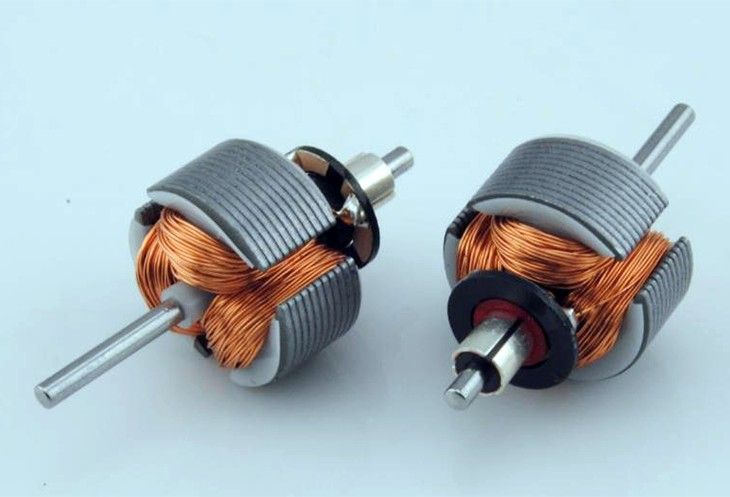I nā lako uila palekana palekana, e like me nā motika pahū, nā mea hoʻololi, uwea electromagnetic, a me nā ballast no nā kukui fluorescent, ʻo kahi ʻāpana he wili kūloko. ʻO nā koi no kēia mau wili, ma ka mechanical a me ka uila, ʻoi aku ka kiʻekiʻe ma mua o nā wili maʻamau.

ʻO ka maʻamau, ʻo ka uea insulated i hoʻohana ʻia no ka wili ʻana i kēia mau wili e pono e palua-insulated, a ʻaʻole pono e emi ke anawaena helu o ka coil ma mua o 0.25mm.
No ka uea enamled i hoʻohana ʻia i ka wili ʻana i kēia mau wili, pono e hoʻohana i ka GB/T6109.2-2008 “Uea keleawe poepoe poliester enameled, Papa 155,” GB/T 6109.5-2008 “Uea keleawe poepoe poliester-imide, Papa 180,” GB/T 6109.6-2008 “Uea keleawe Poe Polyimide Enameled, Papa 220,” a i ʻole GB/T6109.20-2008 “Polyamide-imide Composite Polyester a i ʻole Polyester-imide Enameled Round Copper Wire, Papa 220.”
Eia hou, Papa 1 hiki ke hoʻohana ʻia ka uea keleawe poepoe enameled e like me ka mea i ʻōlelo ʻia ma kēia mau kūlana, inā ua hele ʻo ia i nā hoʻokolohua kūpono i hōʻike ʻia ma nā kūlana.
Ma hope o ka wili ʻana, pono e hoʻohana i kahi mea impregnating kūpono e hoʻonui i nā waiwai insulation o nā wili.
Pono ke kaʻina hana impregnation e hahai i ke ʻano i kuhikuhi ʻia e ka mea hana, ka hoʻohana ʻana i nā ʻenehana e like me ke kuʻi ʻana, kahe ana, a i ʻole ka impregnation kaomi ʻana (VPI) e hoʻopiha i nā āpau ma waena o nā wili wili a hōʻoia i ka pili ikaika. Inā loaʻa nā mea hoʻoheheʻe i ka impregnating agent, ʻO ka impregnation a me ka maloʻo e hana ʻelua e ʻae i ka hoʻoheheʻe ʻana.
ʻO ka maʻamau, ʻO nā ʻano hana e like me ka pulupulu ʻana a i ʻole ka uhi ʻana no ka insulating windings i manaʻo ʻia ʻaʻole pono no lako uila pahū. Pono e nānā pono i kēia ma ka hana ʻenekinia.
Eia kekahi, no ka wili uila kiʻekiʻe, pono e mālama ʻia nā wiliwili i hoʻopaʻa ʻia me ka pena anti-corona i mea e pale ai i nā pōʻino hou aʻe i hoʻokumu ʻia e ka hoʻokuʻu ʻana o ka corona..
I nā mea uila palekana i hoʻonui ʻia, ina na kaa, nā wili electromagnetic, a i ʻole nā wili o nā mea hana ʻē aʻe, pono lakou e lako me mahana wela nā mea pale no ka pale ʻana i ka nui o nā mahana palena ma lalo o ka hana maʻamau a i ʻole nā kūlana ʻino i ʻike ʻia.
Inā ʻaʻole ʻoi aku ka wili ʻana ma mua o ka palena wela ma lalo o ke kaumaha mau (e like me ka laka rotor kaʻa), a inā ʻaʻole pili ka wili ʻana i ke kaumaha (e like me ka ballast no nā kukui fluorescent), a laila ʻaʻole pono ia i kahi mea pale wela.
Ke hoʻolako ʻia nā lako uila i hoʻonui ʻia me ka pale wela, hiki ke hoʻokomo ʻia kēia mau mea ma loko a ma waho paha. ʻOiai, pono e loa'a i ka mea pale ka pono ʻano pahū a pono e loiloi pū ʻia me nā lako i pale ʻia.
 Pahū ʻo Shenhai
Pahū ʻo Shenhai
